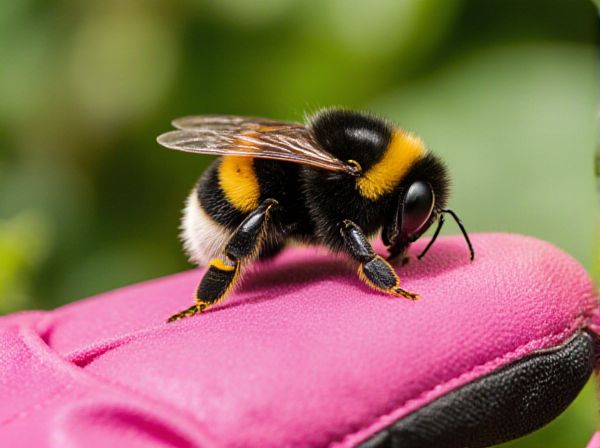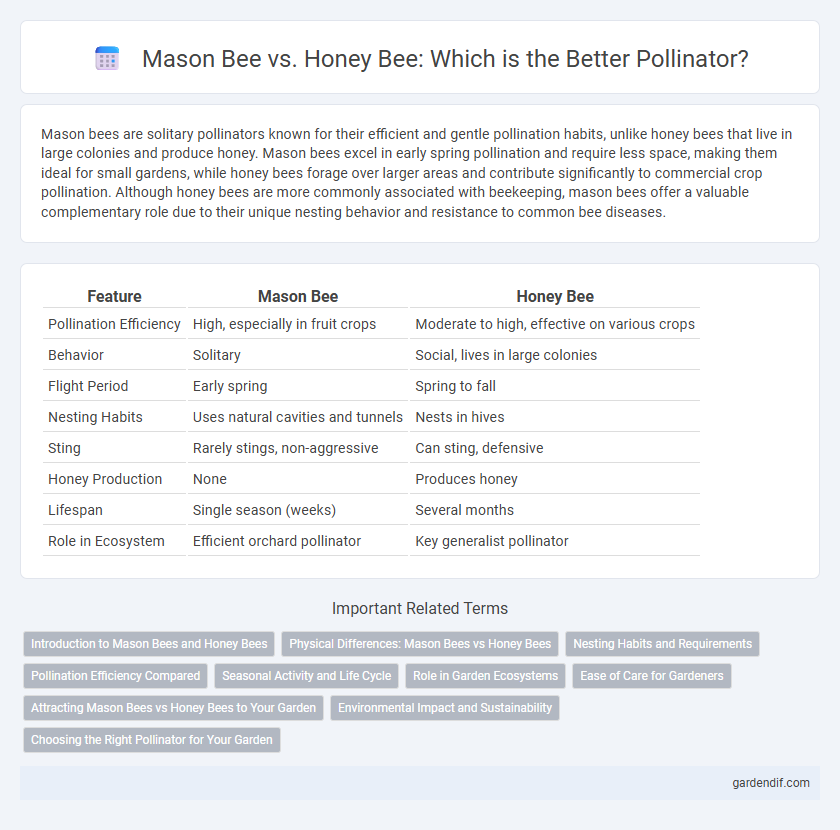
Mason Bee vs Honey Bee Illustration
Mason bees are solitary pollinators known for their efficient and gentle pollination habits, unlike honey bees that live in large colonies and produce honey. Mason bees excel in early spring pollination and require less space, making them ideal for small gardens, while honey bees forage over larger areas and contribute significantly to commercial crop pollination. Although honey bees are more commonly associated with beekeeping, mason bees offer a valuable complementary role due to their unique nesting behavior and resistance to common bee diseases.
Table of Comparison
| Feature | Mason Bee | Honey Bee |
|---|---|---|
| Pollination Efficiency | High, especially in fruit crops | Moderate to high, effective on various crops |
| Behavior | Solitary | Social, lives in large colonies |
| Flight Period | Early spring | Spring to fall |
| Nesting Habits | Uses natural cavities and tunnels | Nests in hives |
| Sting | Rarely stings, non-aggressive | Can sting, defensive |
| Honey Production | None | Produces honey |
| Lifespan | Single season (weeks) | Several months |
| Role in Ecosystem | Efficient orchard pollinator | Key generalist pollinator |
Introduction to Mason Bees and Honey Bees
Mason bees (Osmia species) and honey bees (Apis mellifera) are essential pollinators, each with unique behaviors impacting ecosystems and agriculture. Mason bees, solitary and non-aggressive, excel in early spring pollination of fruit trees, while honey bees live communally in hives, producing honey and supporting large-scale crop pollination. Understanding the differences in habitat, life cycle, and pollination efficiency between mason bees and honey bees is crucial for optimizing pollinator management and biodiversity conservation.
Physical Differences: Mason Bees vs Honey Bees
Mason bees are smaller, typically measuring about 12-14 mm in length, with a robust, hairy body adapted for efficient pollen collection, while honey bees are larger, around 15 mm, with a more slender, less hairy body. Mason bees have a metallic blue or greenish sheen, contrasting with the golden-brown coloration and distinct black bands of honey bees. The legs of mason bees are equipped with dense pollen-carrying hairs on the abdomen, whereas honey bees transport pollen primarily on their hind legs using pollen baskets known as corbiculae.
Nesting Habits and Requirements
Mason bees nest in small cavities such as hollow stems and wood holes, requiring mud or similar materials to construct their individual brood cells, making them solitary pollinators with minimal space needs. In contrast, honey bees build large communal hives in hollow trees or man-made boxes, requiring ample space for wax combs and complex colony structures to support thousands of individuals. The nesting habits of mason bees support localized pollination without hive maintenance, whereas honey bees depend on extensive nesting infrastructure and social cooperation.
Pollination Efficiency Compared
Mason bees exhibit higher pollination efficiency than honey bees due to their solitary foraging behavior and greater flower visitation rate per individual. Unlike honey bees, which rely on colony-based foraging, mason bees are more effective at transferring pollen because of their fuzzy bodies that trap and distribute pollen more efficiently. Studies indicate that a single mason bee can pollinate an area comparable to dozens of honey bees, making them superior pollinators for fruit trees and early spring blossoms.
Seasonal Activity and Life Cycle
Mason bees exhibit a concentrated seasonal activity primarily in early spring, remaining active for approximately 4 to 6 weeks, aligning with early blooming plants, while honey bees maintain year-round foraging with peak activity from spring through fall. Mason bees have a univoltine life cycle, completing one generation per year, with solitary females nesting in pre-existing cavities, whereas honey bees have a perennial colony structure featuring continuous brood rearing across multiple seasons. The differing life cycles and seasonal activity patterns of mason bees and honey bees significantly influence their roles and efficiency as pollinators in various ecosystems.
Role in Garden Ecosystems
Mason bees and honey bees both play vital roles in garden ecosystems, with mason bees being highly efficient solitary pollinators that excel at pollinating early spring blossoms and fruit trees. Honey bees, as social insects, contribute by pollinating a wide variety of plants across longer foraging distances, supporting large-scale pollination in gardens and agricultural settings. Their complementary pollination behaviors enhance plant diversity, fruit set, and overall garden health.
Ease of Care for Gardeners
Mason bees require minimal care, thriving in small nesting tubes and needing no hives or complicated maintenance, making them ideal for beginner gardeners. Honey bees demand consistent hive management, including regular inspections, pest control, and seasonal interventions to ensure colony health. For gardeners seeking low-maintenance pollinators, mason bees offer an efficient and user-friendly alternative to honey bees.
Attracting Mason Bees vs Honey Bees to Your Garden
Mason bees are attracted to gardens with abundant mud sources and nesting sites like hollow stems or wood cavities, whereas honey bees seek out flowering plants with abundant nectar and pollen. Providing diverse native wildflowers and ensuring untreated wood blocks can significantly increase mason bee attraction while maintaining a variety of flowering plants supports honey bee populations. Creating habitats that cater to specific preferences of both species enhances overall pollination efficiency in your garden.
Environmental Impact and Sustainability
Mason bees contribute significantly to environmental sustainability by requiring minimal maintenance and thriving without commercial fertilizers or pesticides, unlike honey bees, which often depend on managed hives and chemical treatments that can harm ecosystems. Their solitary nesting habits reduce the risk of disease transmission, promoting biodiversity and ecosystem stability. Honey bees, while effective pollinators, face challenges from colony collapse disorder and rely heavily on human intervention, impacting environmental balance and long-term sustainability.
Choosing the Right Pollinator for Your Garden
Mason bees are solitary pollinators that excel in early spring pollination and require minimal maintenance, making them ideal for home gardens focused on fruit and vegetable production. Honey bees thrive in larger colonies, produce honey, and are effective pollinators for a broad range of plants, but they require more upkeep and can be less efficient per bee in confined garden spaces. Choosing the right pollinator depends on garden size, crop type, maintenance capacity, and the specific pollination needs of your plants.
Mason Bee vs Honey Bee Infographic

 gardendif.com
gardendif.com